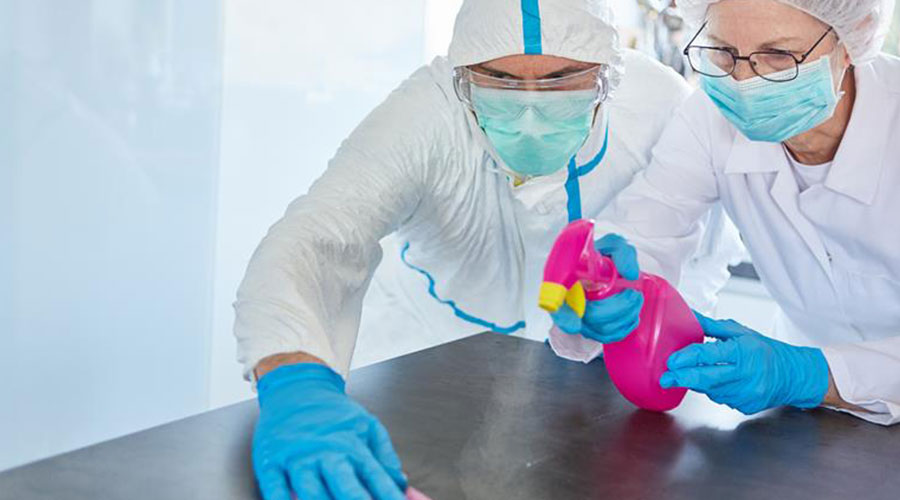In 2016, Stephanie Dancer wrote an assessment of the importance of and challenges with cleaning in hospitals:
“More evidence is emerging on the role of cleaning and decontamination for reducing healthcare-associated infection. Timely and adequate removal of environmental pathogens leads to measurable clinical benefits for patients.
“As automated dirt removal is assumed to be superior to human effort, there is a danger that traditional cleaning methods are devalued or ignored. Fear of infection encourages the use of powerful disinfectants for eliminating real or imagined pathogens in hospitals without appreciating toxicity or cost benefit.
“Furthermore, the efficacy of these agents is compromised without prior removal of biofilm. Microbiocidal activity should be compared against physical removal of soil in standardized and controlled studies to understand how best to manage contaminated healthcare environments.”
Additional issues are compounding these challenges.
First, there is a cleaning issue with older hospitals being poorly maintained. It is much easier to clean intact rather than disintegrating surfaces on furniture, fixtures and floors. Asking staff to clean stained, damaged, torn, scratched, cracked or non-existent areas destroys incentive, and it allows additional environmental niches for biofilm containing pathogens.
Second is the crisis of dry- and wet-surface biofilms resistance to most disinfectants. Biofilm forms when microorganisms attach to the surface of an object and reproduce. They protect each other by secreting a slimy, glue-like substance known as extracellular polymeric substance (EPS).
Bacillus subtilis, a strong EPS producer, has been shown to resist chlorine dioxide (0.03 percent), hydrogen peroxide (7.5 percent) and peracetic acid (2.25 percent), and it protects Staphylococcus aureus from peracetic acid (0.35 percent).
Bacteria within biofilms are more difficult to remove using a wet cloth compared to bacteria outside of biofilms. In a 2009 study in the “Journal of Hospital Infections,” researchers found they could wipe away 99.99 percent of a bacteria culture from a stainless-steel surface with one wipe of a wet cloth. After five wipes, they had removed 99.999 percent of the bacteria culture.
Researchers then grew the same bacteria in a dry-surface biofilm. After 50 wipes with a wet cloth, they removed a little over 96 percent of the bacteria culture from the surface. Researchers determined that biofilm bacteria are 100 times harder to remove than bacteria that is not contained in a biofilm.
Are environmental services managers using the right disinfectant in their cleaning operations? Many common disinfectants do not have the ability to kill bacteria in a biofilm, but there is a U.S. Environmental Protection Agency (EPA) test for a disinfectant biofilm claim on hard nonporous surfaces. Unfortunately, there is no biofilm list letter, and claims can only be found on a chemical’s master label, which is approved by the EPA.
EPA’s List P includes antimicrobial products registered for claims against C. auris. There are 38 products from 13 chemical manufacturers on List P. Cross-referencing master labels with List P indicates a small number of products have both a biofilm and C. auris. But some might be considered hazardous to health.
That leaves only a few that have both claims and are safe for disinfection facility-wide. A peer-reviewed paper on the efficacy of disinfectants against C. auris biofilms showed that sodium dichloroisocyanurate achieved a 7-log reduction at 1,000 parts per million (ppm), which is significantly lower than the 4,306ppm typically used in healthcare.
J. Darrel Hicks, BA, MESRE, CHESP, Certificate of Mastery in Infection Prevention, is the past president of the Healthcare Surfaces Institute. Hicks is nationally recognized as a subject matter expert in infection prevention and control as it relates to cleaning. He is the owner and principal of Safe, Clean and Disinfected. His enterprise specializes in B2B consulting, webinar presentations, seminars and facility consulting services related to cleaning and disinfection. He can be reached at darrel@darrelhicks.com, or learn more at www.darrelhicks.com.

 Building Sustainable Healthcare for an Aging Population
Building Sustainable Healthcare for an Aging Population Froedtert ThedaCare Announces Opening of ThedaCare Medical Center-Oshkosh
Froedtert ThedaCare Announces Opening of ThedaCare Medical Center-Oshkosh Touchmark Acquires The Hacienda at Georgetown Senior Living Facility
Touchmark Acquires The Hacienda at Georgetown Senior Living Facility Contaminants Under Foot: A Closer Look at Patient Room Floors
Contaminants Under Foot: A Closer Look at Patient Room Floors Power Outages Largely Driven by Extreme Weather Events
Power Outages Largely Driven by Extreme Weather Events